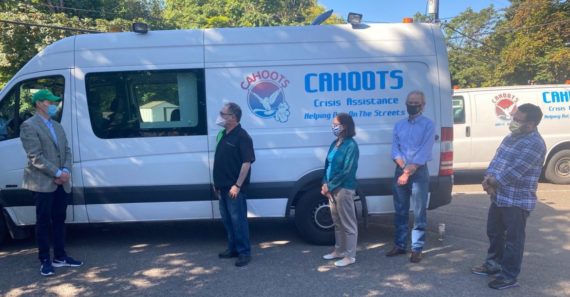 photo courtesy CAHOOTS/White Bird clinic
photo courtesy CAHOOTS/White Bird clinic
(10-30-20) The fatal police shooting of Walter Wallace Jr., this week in Philadelphia, who had a mental illness and was wielding a knife, made national headlines, drew comments from both presidential candidates, sparked rioting, and once again raised questioned about whether the police should be the first to respond when someone is in a mental health crisis.
CNN yesterday posted a story about five other recent fatal shootings of Americans in the midst of a mental health crisis. At least one in four fatal shootings by police involve a person with a mental illness.
Whenever talk turns about shifting responsibility from the police to mental health workers, the Crisis Assistance Helping Out On the Streets ( CAHOOTS) program in Eugene, Ore., is cited as a successful example of how communities can safely lessen police involvement. An article written by Mark Obbie in The Crime Report highlights the “most thorough, thoughtful stories” about CAHOOTS. Thanks to Obbie and the Crime Report for sharing this index.
Would the CAHOOTS model work in your community?
Can Social Workers Replace Cops? One Experiment, From All Angles
published in The Crime Report published by the Center on Media Crime and Justice at John Jay College
For the past three decades, the city of Eugene, Ore., has conducted a long-running experiment in replacing police officers with social workers to handle mental-health crises and other quality-of-life calls to 911.
The program, Crisis Assistance Helping Out On the Streets ( CAHOOTS) has hardly been a secret.
Long before this year’s protests over police mishandling of such calls, and demands to “defund” police by shifting some responsibilities to other service providers, CAHOOTS often attracted attention from national and regional news media.
Lately, though, there’s been a flood of coverage of the program’s work, along with stories about copycats springing up around the country (such as Denver, Indianapolis and Chicago), debates in multiple cities about whether to join the trend, and dissections of the various policy alternatives to be considered.
In my role as the criminal justice “solutions specialist” at Solutions Journalism Network, where I archive and spotlight news stories on crime-reduction solutions with evidence of effectiveness, I sifted through the CAHOOTS cornucopia to curate a new collection of some of the most thorough, thoughtful stories.
Best stories about CAHOOTS with links
While these stories cover common ground in summarizing CAHOOTS’ track record – saving its city money on police while lessening the danger of violent confrontations and unnecessary arrests and incarceration, and while getting needed services for troubled people – each of the seven stories in this collection approaches the key questions from a different point of view:
-
- The Wall Street Journal, in what is credited as the story that first brought national attention to CAHOOTS, focused on how an agency like this sells itself politically.
- USA Today provided an overview of the various types of responses to this problem, with a look at whether police should get more training or should be excluded from such calls.
- The New York Review of Books published what, in my estimation, is the most insightful street-level view of CAHOOTS’ work, while grappling with intriguing questions about how to balance short- and long-term solutions.
- Bloomberg CityLab’s thorough look at CAHOOTS makes an interesting side trip to Stockholm, where a similar program exists.
- The Denver Post reported on the initial promising signs from a CAHOOTS-like program that’s just started in Denver.
- City newspaper in Rochester, N.Y., responded to the death of Daniel Prude in Rochester police custody by explaining why CAHOOTS’ approach couldn’t simply be plopped down in Rochester without significant changes.
- Santa Cruz Local, in California, took the same approach as Rochester’s City story, with a particular focus in its podcast on budget questions.
As several of the stories make clear, calls to 911 for mental health crises and problems related to homelessness, substance abuse and petty interpersonal disputes consume huge amounts of policing resources and often lead to violence and repetitive cycles of 911 calls because underlying problems don’t get solved.
Whether by making teams of unarmed social workers and medics the first responders on such calls, teaming them with police, or giving police more extensive training, these experiments around the country are showing ways to approach these questions in safe and effective ways.

Mark Obbie
This collection joins a number of others my colleagues and I have compiled on such criminal justice topics as use-of-force policies, bail reform, police-community relations, community-violence prevention, and violence interrupters.
All of the stories in these collections are among the more than 10,000 solutions stories archived in our Solutions Story Tracker as part of our nonprofit’s effort to promote better reporting on effective solutions to complicated social problems.
Editor’s Note: The Center on Media, Crime and Justice at John Jay College, publisher of The Crime Report, has collaborated with the Solutions Journalism Network on several projects.



